NAM Speaks Out Against New EPA Regulations
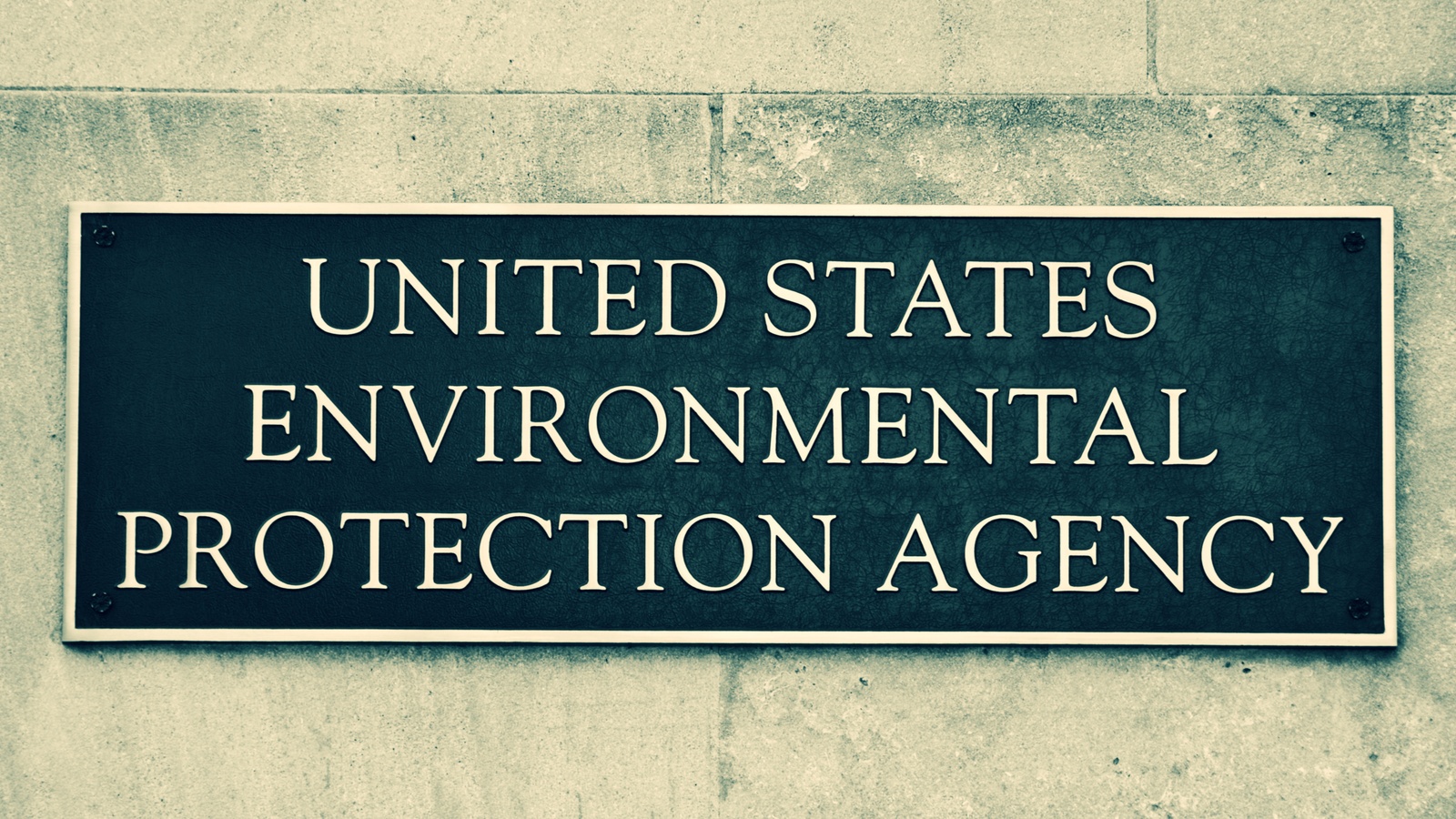
Manufacturers across the United States have long been leading the way on sustainability. From outpacing international competitors on emission reductions to making investments in clean technologies, the industry has implemented best practices for others to use and blazed a trail for them to follow.
NAM Director of Energy and Resources Policy Chris Morris emphasized manufacturers’ track record during a hearing before the Environmental Protection Agency last week, where he explained to policymakers that their proposed air quality rules would stifle rather than enhance manufacturers’ efforts. Here’s what he had to say.
A record of leadership: “Our industry has championed environmental stewardship at every turn, and our members have invested heavily in new processes and technologies that have made manufacturing in the U.S. cleaner and more sustainable than ever,” said Morris.
- “This innovation in the manufacturing sector has played a key role in the reduction of air pollution we have seen over the last 50 years.”
Manufacturers’ impact: “Across the board, levels of major pollutants have declined dramatically, and we are outpacing our global competitors in air quality improvements,” said Morris.
- “According to the EPA, the U.S. has reduced six common NAAQS pollutants, including PM2.5, by 78% between 1970 and 2020.”
- “Additionally, EPA data shows that PM2.5 air quality has improved 44% since 2000. Manufacturers are committed to ensuring that progress continues.”
The challenge: New proposed regulations from the EPA would have a number of negative effects, Morris noted.
- Tighter air quality standards would make permitting more difficult, raise compliance costs and make it harder for manufacturers in the United States to compete with companies abroad—especially at a time when manufacturers are concerned about the country’s economic outlook.
The path forward: Morris urged policymakers to ensure that current regulations are fully implemented before they propose new ones, and to work together with innovative manufacturers on smart solutions.
- “The U.S. has some of the best environmental standards in the world, and American manufacturers are consistently reducing emissions, conserving critical resources, protecting biodiversity, limiting waste and providing safe products and solutions so others in our country can do the same,” said Morris.
- “But in order to maintain our environmental leadership, we need better regulations.”
The last word: “In our view, environmental protection and a thriving economy are not mutually exclusive,” said Morris. “We can have both—but it requires working together toward a constructive solution. Manufacturers are committed to smart, strong environmental safeguards and improving the lives of all Americans so that no one—and no community—is left behind.”
“Competing to Win” Comes to Louisiana
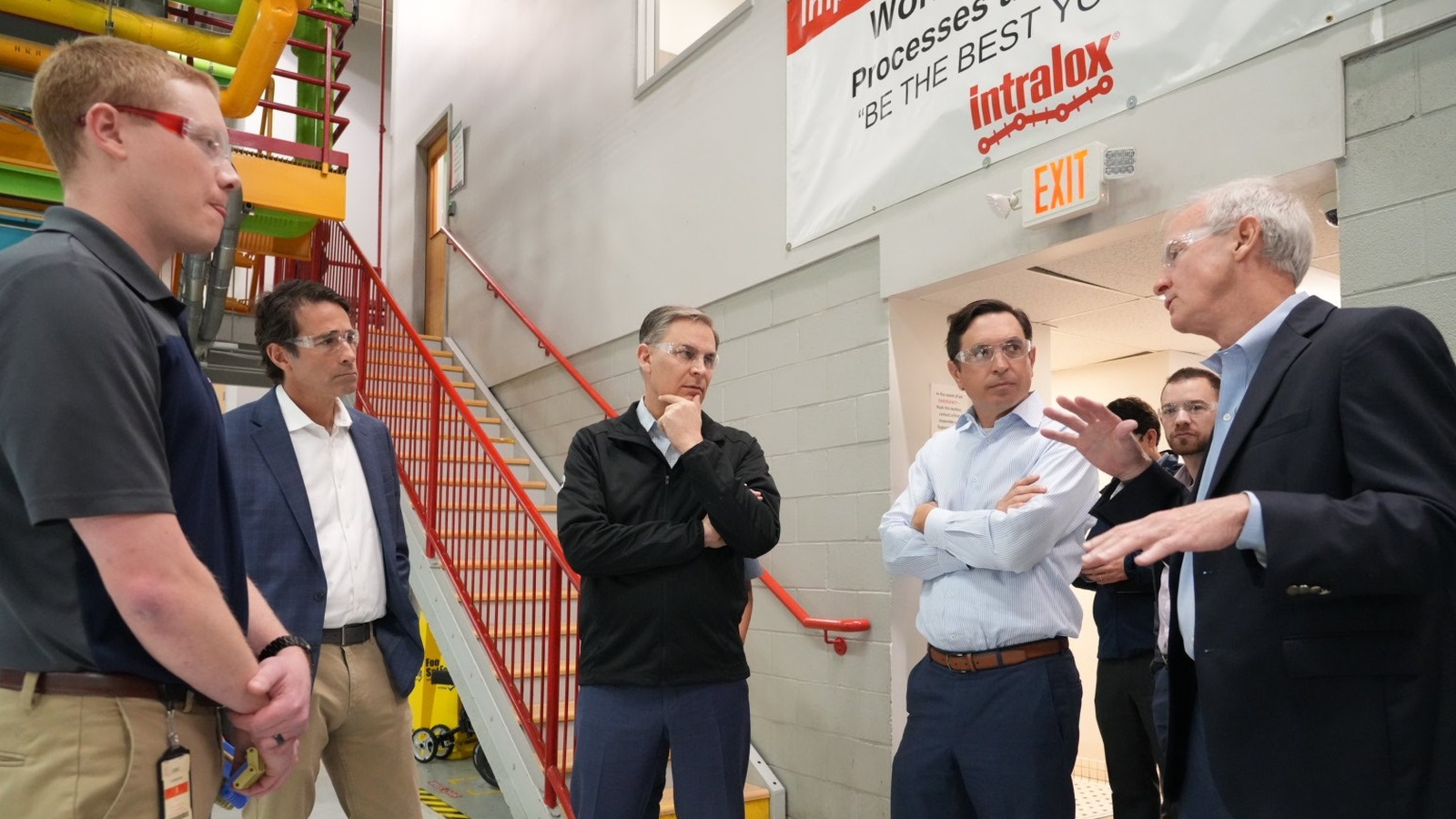
Few things are more quintessentially Louisianan than seafood and Tabasco sauce, and on the third stop of the NAM’s Competing to Win Tour on Thursday, NAM President and CEO Jay Timmons got to spend some time with both.
The first stop: Laitram LLC, the Harahan, Louisiana–based manufacturing leader in seafood and nuts processing equipment, played host to Timmons, Louisiana Rep. Garret Graves (recently tapped by House Speaker Kevin McCarthy as Elected Leadership Committee chair) and Louisiana Association of Business and Industry President and CEO Stephen Waguespack.
- Laitram President and CEO Jay Lapeyre (who also serves as chairman of the Cato Institute Board of Directors) and his team led the group through a facility tour of Intralox, a subsidiary of Laitram specializing in conveyer belts and equipment that improve productivity, food safety and reliability in high-speed package sorting.
- Timmons, Rep. Graves and Waguespack spoke with line employees across the facility, and Timmons was impressed by the company’s successes in employee retention: “Nearly everyone I met had been there a decade or more … One team member recently marked 46 years with the company,” he noted afterward.
Talking policy: Timmons moderated a roundtable discussion on manufacturing policy opportunities and challenges with Laitram’s senior staff, Rep. Graves and Waguespack after the tour.
- Lapeyre and his team expressed concerns about pass-through tax rates, which impact Laitram given that it is an S-Corp. They also raised alarms about the recent phaseout of pro-growth tax deductions for research and development and bonus depreciation.
- Trade emerged as a top priority for Laitram and its global enterprise, and Lapeyre also shared his perspective on the need for more regulatory certainty, particularly in the light of a potential new rule from the Federal Trade Commission limiting the use of noncompete agreements.
- Meanwhile, Rep. Graves emphasized the continued importance of protecting tax reform and pointed to ongoing efforts in Congress to advance permitting reform.
The second stop: The NAM team then headed to Avery Island, about two hours outside of New Orleans, where they visited McIlhenny Company, the maker of the iconic red-and-green-bottled Tabasco pepper sauce.
- Timmons was given a full tour of the 155-year-old company’s facilities, which included stops at the manufacturer’s barrel-aging warehouse, blending facility, bottling and packing plant and its onsite restaurant.
- McIlhenny Chief Operating Officer Michael Terrell—a fourth-generation employee of the company—and Agricultural Manager Christian Brown—a sixth-generation employee—guided the tour around the facility, which showed off some of the manufacturer’s recent bottling-plant innovations. These included label readers, case packers and a packet line, as well as several sustainability initiatives.
The last word: As Timmons said at the outset of the competitiveness tour, “The story of manufacturing in America is one of resilience and defying the odds. All manufacturers ask is that in Washington, when it comes to policy, don’t stack those odds against us.”
Timmons to Congress: Permitting Reform Urgently Needed
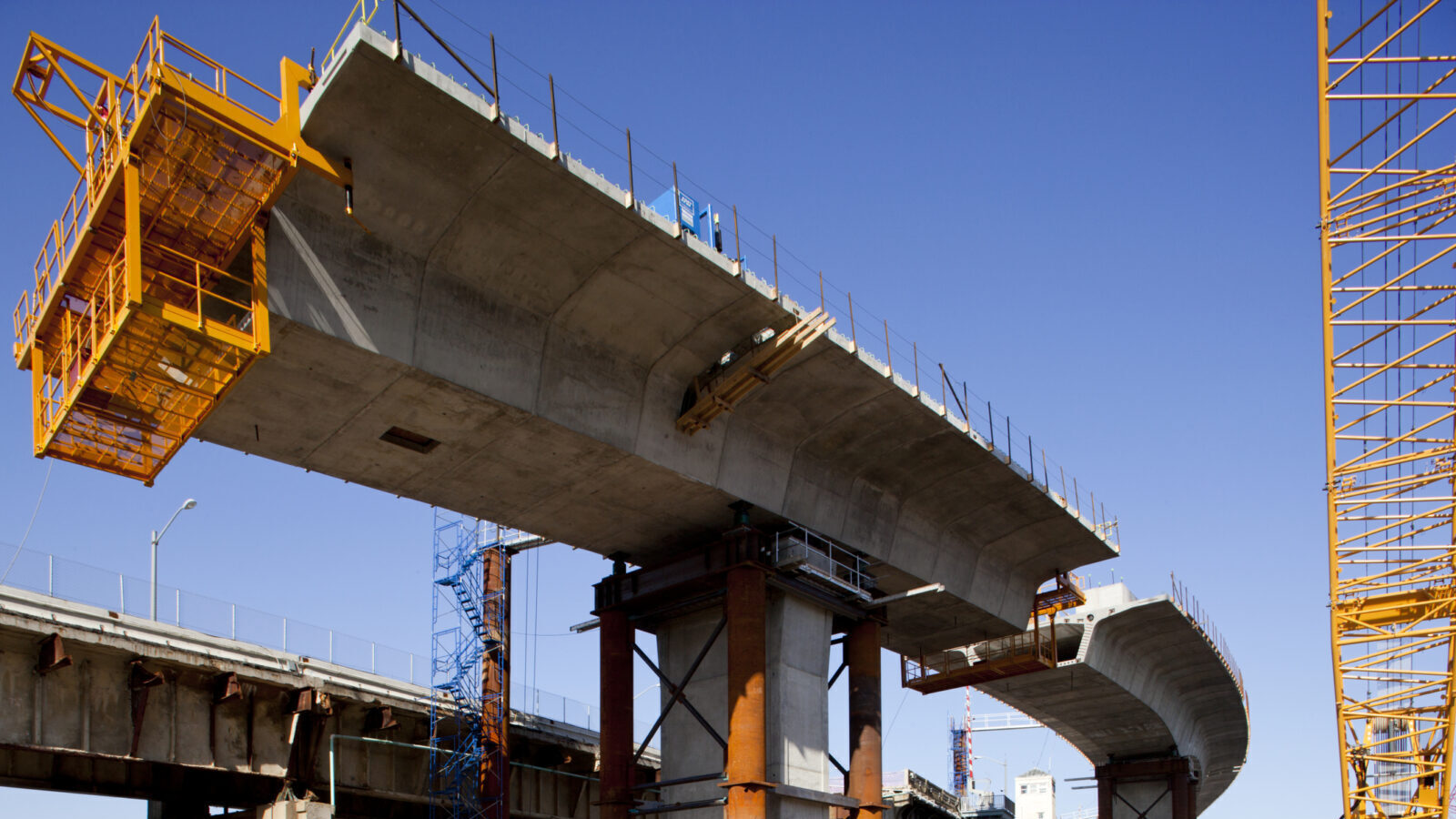
NAM President and CEO Jay Timmons has been making the most of his time on the road during the Competing to Win Tour, delivering a strong message to congressional leaders about top manufacturing priorities. He did so again yesterday on permitting reform with congressional leaders in Washington:
- “Some of the biggest obstacles preventing manufacturers—and therefore the entire American economy—from reaching our full potential are the permitting delays, red tape and complicated bureaucracy that have plagued us for decades,” he told the leadership of several House committees.
He went on to cite a number of different areas in which permitting reform is desperately needed, including . . .
Energy: Permitting reform is crucial to almost every sector of energy manufacturing, from oil and gas all the way to nuclear and clean energy technologies.
- “For example,” Timmons noted, “the siting of and infrastructure for hydrogen power generation and transportation and for advanced, small modular and micro-nuclear reactors have progressed far too slowly.”
- “Manufacturers depend on access to reliable and affordable energy to expand, which is why we support reforms that would foster transparent, streamlined and timely federal regulatory processes for the siting, permitting and licensing of energy delivery infrastructure of all types,” he continued.
Transportation: Manufacturers also need railroads, highways, airports and ports to run their operations and get their products out the door.
- “Yet obtaining permit approvals for these projects often takes years, especially when reviews are piecemeal and duplicative,” Timmons pointed out. “[M]any companies are waiting on the sidelines because transportation infrastructure construction moves too slowly—or not at all.”
- “To ensure the broad and beneficial impact of [the bipartisan Infrastructure Investment and Jobs Act of 2021] … it is critical to clear permit backlogs and ease processing timelines,” he said.
Resource development: Manufacturers prioritize sustainability, Timmons noted, but “restricting access to America’s abundant natural resources hinders our ability to strengthen domestic supply chains.”
- “The inconsistent administration of critical mineral policies, for example, has limited our ability to use a wide range of resources that lie on and beneath federal lands—resources that are critical to producing everything from cars to medical devices,” he added.
- “Streamlining resource permitting and leasing policies will help stabilize manufacturing supply chains, control costs for consumers, reduce our reliance on foreign countries and create jobs in the U.S.”
Environmental standards: Manufacturers have worked steadily to improve U.S. air quality, helping to “lead our country to the cleanest air in the modern world,” said Timmons.
- “Unfortunately, when federal agencies continually revise standards before current standards are met and before states have implemented prior mandates, they create unpredictability”—which may mean that new manufacturing facilities get built in other countries instead, where they don’t face as rigorous standards.
- However, if Congress makes regulations more predictable and consolidates review processes, the U.S. “can continue to build on its strong record of environmental stewardship by boosting domestic manufacturing, which is environmentally cleaner than international competitors,” Timmons concluded.
Congressional intent: Congress should make sure that permitting reform isn’t just passed, but also implemented as easily as possible, Timmons advocated.
- It should conform to “on recent and future statutory streamlining efforts such as One Federal Decision,” while making sure federal agencies don’t duplicate each other’s efforts and waste time.
The last word: “Permitting affects every aspect of our lives—from our economic security to our national security,” said Timmons. “[I]f we seize this opportunity to lead, there is no limit to what manufacturers in the United States can accomplish—for the good of our people and for the good of the world.”
Timmons Gives NAM State of Manufacturing Address
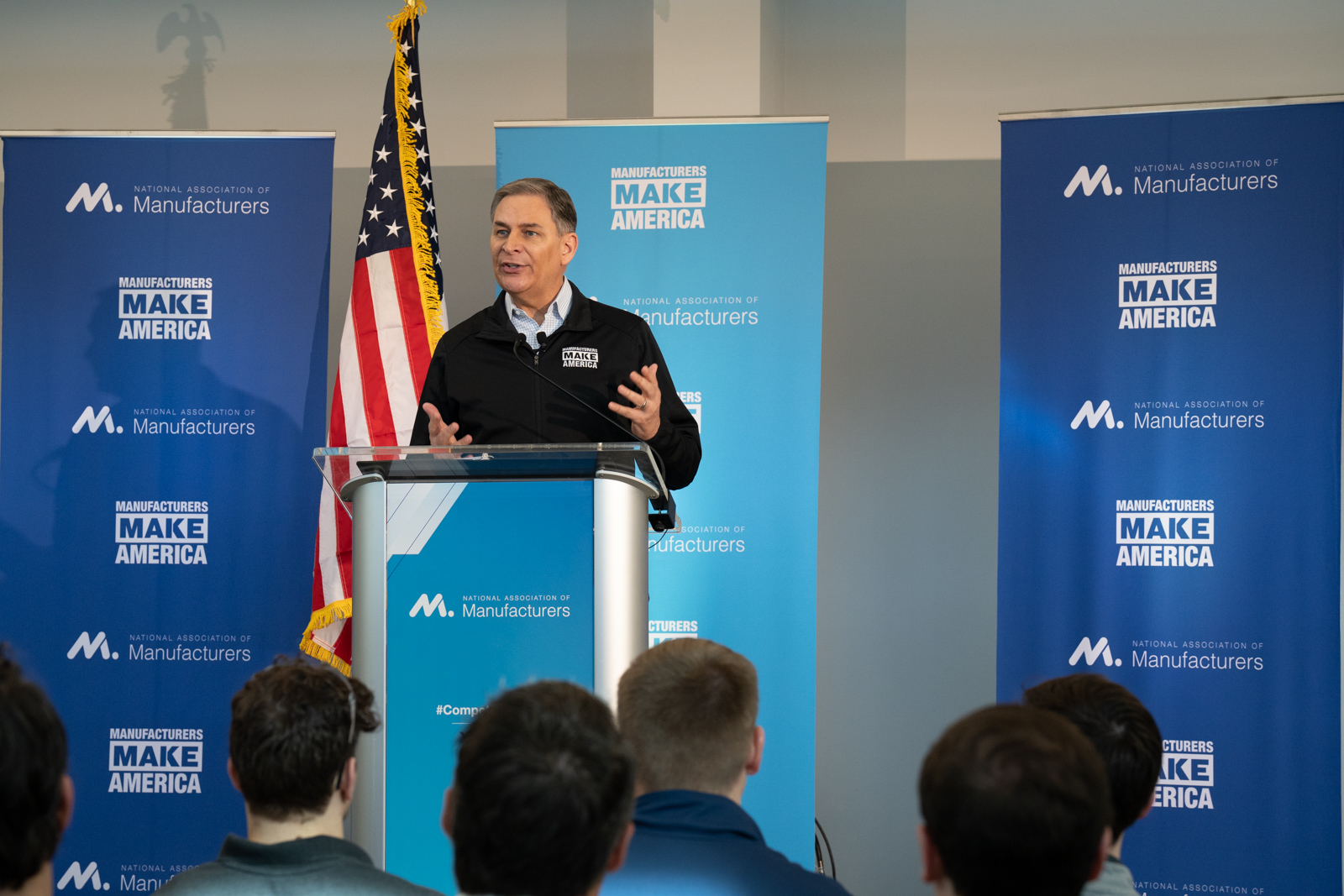
Manufacturing has a leading role in the U.S. economy—but there is still a great deal more to do. That was the message at this year’s NAM State of Manufacturing Address from NAM President and CEO Jay Timmons.
Timmons spoke to a gathering of manufacturing team members and the media at Husco in Waukesha, Wisconsin. In his remarks, he laid out the NAM’s view of where the industry is and where it’s going.
The program: The event began with a message from Kurt Bauer, president and CEO of Wisconsin Manufacturers & Commerce, followed by an introduction from NAM board member Austin Ramirez, president and CEO of global engineering and manufacturing company Husco.
- “Wisconsin manufacturers contribute to the vitality of our state through their innovation, productivity and commitment to customer satisfaction,” said Bauer. “While we face many challenges, we are also in the enviable position of controlling our destiny—as long as we work together to create a shared vision of prosperity and an action plan to achieve it.”
- “We are here to shine a light on the amazing, life-changing work that manufacturers do every day,” said Ramirez. “We are the backbone of the American economy, and we are proud of it.”
The state of manufacturing: Timmons spoke about Russia’s invasion of Ukraine, the importance of the manufacturing industry’s support for the Ukrainian people and the larger struggle between freedom and tyranny.
- “Despite everything happening around us, like the threat of a recession and global conflict, manufacturers are still leading the way forward,” said Timmons.
- “And although our industry and our country will need to make audacious and sometimes uncomfortable changes to adapt to economic, political and global challenges … I’m confident in reporting that the state of manufacturing in America remains steadfast and resolute.”
Manufacturing solutions: Timmons cited a variety of manufacturing challenges, then detailed the NAM’s plans to fight for manufacturers across the United States.
- Supporting immigration: “For so many manufacturers in America right now, there are more open jobs than there are people to fill them,” said Timmons. “One of the many ways we fill those jobs and keep our economy moving is welcoming immigrants into our workforce … just like we have in the past to build a stronger, more prosperous America.”
- Promoting permitting reform: “Permitting reform means making it easier to get permission to build that new road or power plant, or for manufacturers to build new facilities,” said Timmons. “If Washington could just cut through the bureaucracy and streamline processes, like you do in your businesses every single day, we could do more for this country.”
- Fighting for tax fixes: “The NAM is determined to get Congress to restore incentives for R&D and get our business tax rates and structure back on track to enable us to compete globally,” he said. “And then, let’s lock in competitive rates for small businesses … so that you can plan confidently for the future.”
- Competing with China: “If we’re going to counter China, then we must hold China accountable for the trade commitments it has already made to the U.S.,” said Timmons. “And we have to forge ambitious, cutting-edge trade agreements with our allies. Other countries aren’t waiting around. So, let’s think big. And let’s be bold.”
- Pushing back on new EPA rules: “We’re going to tell the EPA that manufacturers are already leading [in cleaning] our air,” said Timmons. “The government shouldn’t enact rules that, however well-intentioned, would make it more difficult to achieve our environmental goals, slow our economic growth and push us closer toward recession.”
The last word: “History shows us that as long as manufacturers lead the way, America and our democracy will remain that beacon of freedom and hope for people around the world,” said Timmons. “Manufacturers have been, and always will be, in word and deed, the arsenal of democracy. And working together, I know we will keep making this a manufacturing decade.”
Timmons: Biden’s Visit Shows the World That the U.S. Stands with the Ukrainian People
Washington, D.C. – National Association of Manufacturers President and CEO Jay Timmons released the following statement on President Biden’s visit to Ukraine:
“President Biden’s visit to Ukraine the week of the anniversary of Russia’s brutal and unprovoked invasion shows the world that the United States stands with the Ukrainian people and that our support is unwavering.
“The struggle in Ukraine is more than a war between two countries. It’s a struggle between freedom and tyranny. Manufacturers believe that there are two systems evolving in this world—one that enriches lives and lifts people up into freedom and prosperity, and the other that is oppressive and robs people of their liberty. We must continue to support the Ukrainian people, ensuring that critical supplies keep moving and investing in and rebuilding this war-torn country.
“Manufacturers in the U.S. have a long and proud history of standing firm in support of democracy, the rule of law, transparency, freedom and opportunity. The NAM and our members have demonstrated our unwavering support for Ukraine and its people, and the NAM spoke out firmly against the war with our Board of Directors passing unanimously a resolution at our meeting in March 2022. We supported sanctions against Russia, called for the suspension of Permanent Normal Trade Relations with Russia and mobilized humanitarian relief to Ukraine. Additionally, the NAM’s Emergency Response Committee has worked with NAM members and Project HOPE to support the resettlement of Ukrainians in the U.S. As an industry, we are committed to working with our partners to ensure that the Ukrainian people have the support they need to build a future of freedom and prosperity.”
-NAM-
The National Association of Manufacturers is the largest manufacturing association in the United States, representing small and large manufacturers in every industrial sector and in all 50 states. Manufacturing employs nearly 13 million men and women, contributes $2.81 trillion to the U.S. economy annually and accounts for 55% of private-sector research and development. The NAM is the powerful voice of the manufacturing community and the leading advocate for a policy agenda that helps manufacturers compete in the global economy and create jobs across the United States. For more information about the NAM or to follow us on Twitter and Facebook, please visit www.nam.org
How a Tax Change Will Strangle a Small Manufacturer’s R&D
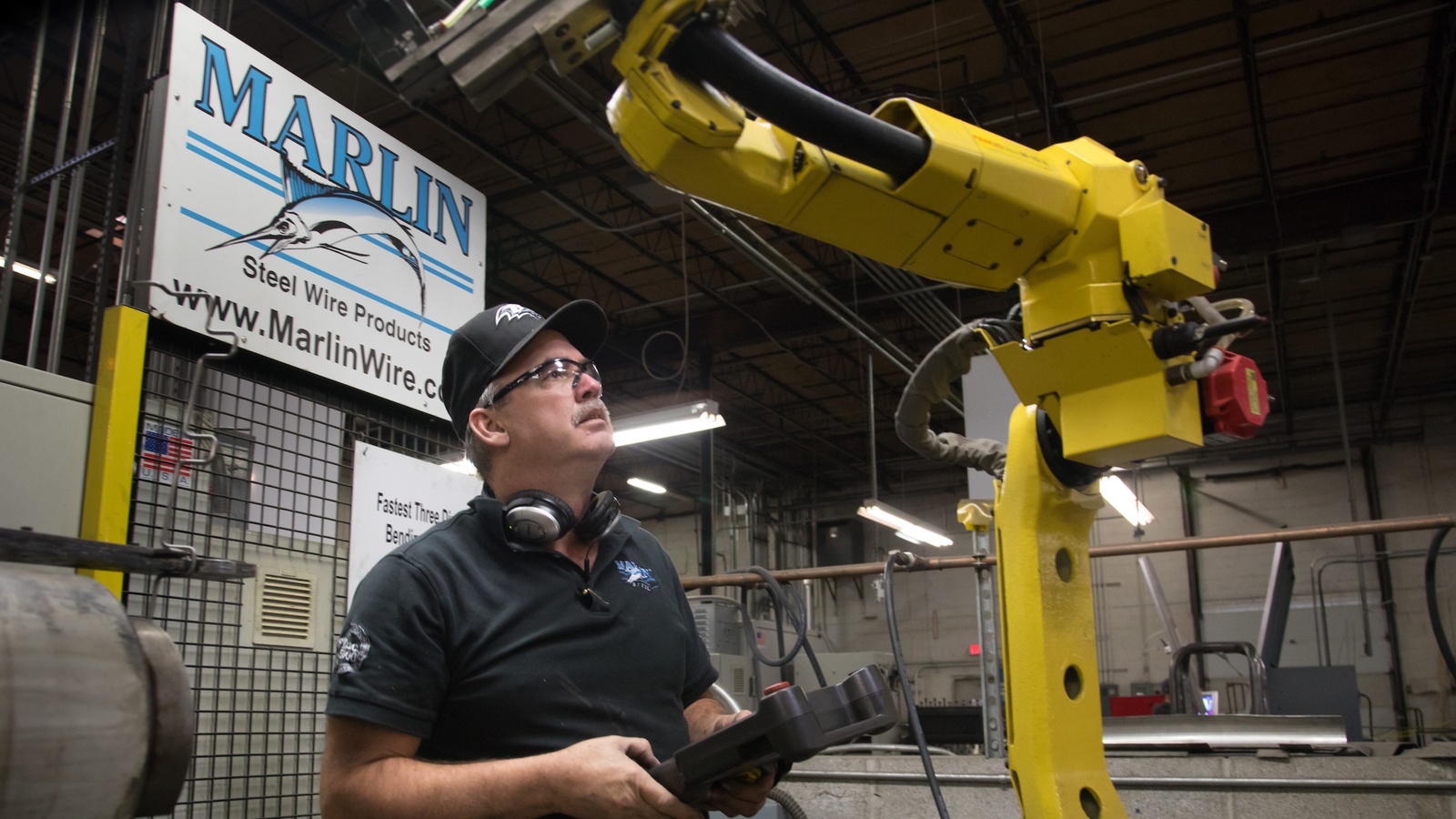
Marlin Steel Wire Products spent its first 30 years making bagel baskets. When Drew Greenblatt bought the custom wire and metal fabrication company in 1998, he thought it would be making bagel baskets for the next 30 years as well—but soon, international competition changed the math.
“Suddenly, China started manufacturing bagel baskets and shipping them to New York City for cheaper than I could get the steel,” said Greenblatt, Marlin’s president and owner. “But then, we got a phone call from an engineer at Boeing who needed an innovative, customizable basket. And that was the eureka moment.”
The shift: Greenblatt recognized that innovation would help him outcompete foreign companies that could manufacture products more cheaply.
- “We realized we couldn’t thrive in a commodities market,” said Greenblatt. “We had to come up with novel ways to make a basket so that it would make no financial sense to buy from China or Mexico.”
- “We wanted to be able to say to buyers, you must buy from the American innovative company, because we’re coming up with such slick ideas that our product blows the competition away.”
The growth: Today, Marlin Steel is nearly 30 times larger than it was when Greenblatt bought it and heavily invested in research and development.
- “Today, Marlin is 15% degreed mechanical engineers,” said Greenblatt. “We have chemical engineers. We’re coming up with the most innovative racks and systems out there.”
- “People are showing us their operations and asking us to reverse-engineer solutions that will work for them. And we’re doing it.”
However . . . A recent tax change threatens to throttle the company’s progress. Until about a year ago, businesses could deduct 100% of their R&D costs in the same year they incurred those expenses.
- But since last year, a tax policy change now requires businesses to spread their R&D deductions out over a period of five years, making it much more expensive to invest in innovation.
The impact: “Our taxes will be $600,000 higher than they should have been this year—we’ll pay four and a half times more on taxes,” said Greenblatt.
- “What that means is that it makes sense for us not to hire six more engineers. Not to buy three more press brakes [machines for bending metal parts] or hire people to work them. It’s incredibly shortsighted, a horrible policy screwup, and the ripple effects are massive.”
The scope: Greenblatt also emphasizes that the tax change will harm many small businesses.
- “People tend to focus on the bigger companies and how it will hurt them—and it will hurt them—but it will also hurt the little guy,” said Greenblatt. “And the little guy is the job creator in America.”
The last word: “American innovation—that’s our secret sauce,” said Greenblatt. “That’s how we’re going to grow jobs and pay people well and give good benefits and steady employment without layoffs. That’s how we’re going to beat a recession. We need to have the coolest, most innovative products in the world. For us, innovation is key.”
NAM Launches 2023 Competing to Win Tour
President and CEO Jay Timmons to Deliver the NAM State of Manufacturing Address
Washington, D.C. – The National Association of Manufacturers will kick off its 2023 Competing to Win Tour on Tuesday, Feb. 21, 2023, traveling to three states and visiting four manufacturing facilities along the way.
The tour will begin in Wisconsin, where NAM President and CEO Jay Timmons will deliver the 2023 NAM State of Manufacturing Address at Husco.
Throughout the week, Timmons will join local manufacturers, employees, media, community leaders and elected officials to discuss the challenging environment facing manufacturers and the urgent need for solutions on issues including immigration reform, permitting reform, workforce development, tax policy and more.
The tour comes as nearly two-thirds of manufacturers are concerned about the challenging economic environment characterized by inflation, supply chain disruption and the workforce crisis, according to the NAM’s latest Manufacturers’ Outlook Survey. More than three-quarters of respondents said pushing back against regulatory overreach should be the top priority of the 118th Congress.
“Our focus on this tour is telling the story of resilient, modern manufacturing—and the tools we need from policymakers to continue leading our economy forward and making the world a better place,” said Timmons. “To unleash our full potential, we need to reinstate critical tax provisions, a smarter, balanced approach to regulations, immigration reform and significant permitting reform, and reject top-down air regulations that cost jobs and snarl supply chains.”
For more than a decade, the annual NAM State of Manufacturing Address has focused the nation’s attention on the industry that is the backbone of the American economy, highlighting the 13 million men and women who are building our future.
The NAM has frequently traveled the country, bringing policy discussions and conversations about the future of work to shop floors, schools, economic clubs, televisions studios, the White House and more.
At a time when the future of work is top of mind for workers and thought leaders alike, the tour will also spotlight the industry’s rapid transformation, while also focusing on manufacturing’s well-paying careers, the industry’s diverse workforce and the real-world solutions for manufacturing’s continued growth.
Tour events will take place in Wisconsin, Indiana and Louisiana. Details are as follows:
Tuesday, Feb. 21 // Wisconsin
8:30 a.m. – 10:30 a.m. CST
Husco
2239 Pewaukee Road
Waukesha, Wisconsin 53188
11:00 a.m. – 12:00 p.m. CST
Waukesha County Technical College
800 Main Street
Pewaukee, Wisconsin 53072
Wednesday, Feb. 22 // Indiana
9:00 a.m. – 11:00 a.m. EST
INCOG BioPharma Services
12050 Exit 5 Parkway
Fishers, Indiana 46037
Timmons will be joined by Sen. Todd Young (R-IN)
Thursday, Feb. 23 // Louisiana
8:30 a.m. – 10:00 a.m. CST
Laitram
200 Laitram Lane
Harahan, Louisiana 70123
2:00 p.m. – 3:30 p.m. CST
McIlhenny Company
Highway 329
Avery Island, Louisiana 70513
MEDIA RSVP: Members of the media interested in covering the tour or attending an event should contact [email protected].
-NAM-
The National Association of Manufacturers is the largest manufacturing association in the United States, representing small and large manufacturers in every industrial sector and in all 50 states. Manufacturing employs nearly 13 million men and women, contributes $2.81 trillion to the U.S. economy annually and accounts for 55% of private-sector research and development. The NAM is the powerful voice of the manufacturing community and the leading advocate for a policy agenda that helps manufacturers compete in the global economy and create jobs across the United States. For more information about the NAM or to follow us on Twitter and Facebook, please visit www.nam.org.
NAM to FAR Council: Rescind Proposed Climate Rule

A draft rule to force federal contractors to make specific and detailed climate disclosures is burdensome, unrealistic and costly to manufacturers. It should be rescinded completely, the NAM told the Federal Acquisition Regulatory Council this week.
The background: In November, the FAR Council—which is composed of the Defense Department, the General Services Administration and NASA—proposed a rule to require climate disclosures from federal contractors, many of whom are manufacturers. The proposed rule would require contractors with more than $50 million in annual federal contract obligations to:
- Disclose their greenhouse gas emissions, including so-called Scope 3 emissions (those attributable to the suppliers and customers throughout a company’s value chain);
- Set targets to reduce their greenhouse gas emissions within a decade (including Scope 3 emissions) based on standards set forth by a third-party nonprofit organization, the Science-Based Targets initiative, and get the targets validated by SBTi; and
- Disclose their climate-related financial risks pursuant to a framework written by a second nonprofit group, the Task Force on Climate-Related Financial Disclosures, and submit those risk disclosures to yet another nonprofit (CDP, formerly the Carbon Disclosure Project).
Why it’s a problem: Compliance with the proposed rule would be difficult, if not wholly unfeasible, prohibitively expensive and time-consuming, NAM Managing Vice President of Tax and Domestic Economic Policy Chris Netram told the FAR Council. It would also impact small businesses within federal contractors’ supply chains given the rule’s focus on Scope 3 disclosures and target setting.
- “The proposed rule would impose significant costs on manufacturers as they work to meet the complex—and in many cases impractical or impossible—requirements of the rule,” Netram said.
- “As a result, manufacturers providing critical goods and services to the federal government, as well as the businesses throughout their supply chains, will be directly and adversely impacted … The national security of the United States could likewise be harmed, as critical contractors could be disqualified from supplying the military, and the required disclosures could expose sensitive information to America’s adversaries.”
What can be done: The FAR Council should rescind the proposed rule in its entirety, Netram said, but if it is intent on making changes, “it must re-propose a rule with substantial revisions to make its requirements more cost-effective and workable for federal contractors and more narrowly tailored to the actual climate-related risks to which the federal government is exposed.”
NAM to EPA: Reverse WOTUS Rule
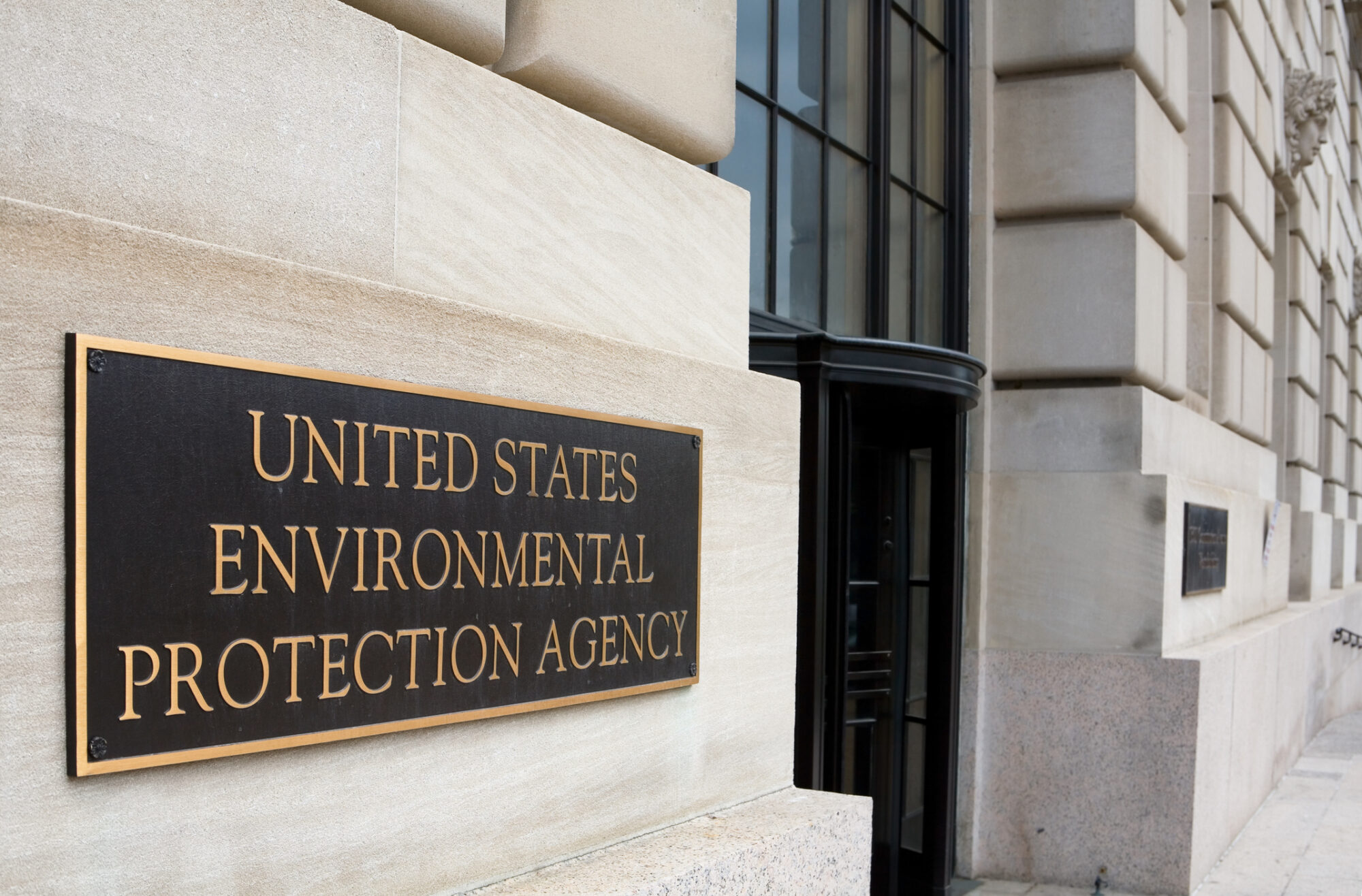
The Environmental Protection Agency’s recently issued rule governing regulation of “navigable waters” is unnecessary, confusing and inconsistent—and the NAM stands ready to work with Congress to overturn it.
The background: In December, the EPA and the U.S. Army Corps of Engineers announced the new regulation, which repealed the Navigable Waters Protection Rule and altered the definition of “Waters of the United States.”
- This month, House Transportation and Infrastructure Committee Chairman Sam Graves (R-MO) introduced a joint resolution of disapproval of the rule under the Congressional Review Act. An identical measure was introduced in the Senate.
- The NAM this week hailed the congressional moves. “Manufacturers welcome action from Congress to challenge the EPA’s proposed WOTUS Rule,” said NAM President and CEO Jay Timmons.
What’s going on now: Ahead of a Transportation and Infrastructure Committee hearing Wednesday, NAM Senior Director of Energy and Resources Policy Nile Elam urged the “educat[ion of] the public and policy stakeholders regarding the immense permitting regulatory efforts necessary under local and state jurisdictions, and the need for a complementary WOTUS rule that advances permitting protections at the federal level while providing certainty for the regulated community.”
- Though many Supreme Court decisions have “touched on” the definition of navigable waters, neither the court nor the EPA has clarified sufficiently, Elam told Water Resources and Environment Subcommittee Chairman David Rouzer (R-NC) and Ranking Member Grace Napolitano (D-CA).
- The new rule also “expands federal jurisdiction beyond traditional navigable waters,” Elam said. “Because of these expansions and ambiguous terms, the careful balance between local and state regulators is unpredictable and can leave permit seekers with little guidance, aside from the need for more time and money to achieve their permitting requests.”
What should come next: Congress must work with stakeholders, the EPA and the Corps on creating clear, predictable and common-sense WOTUS regulations, Elam told the committee. Doing so will “enhanc[e] manufacturers’ ability to deliver their goods, expand their operations and grow their workforce.”
NAM Pushes Back on Harmful New Air Regulations
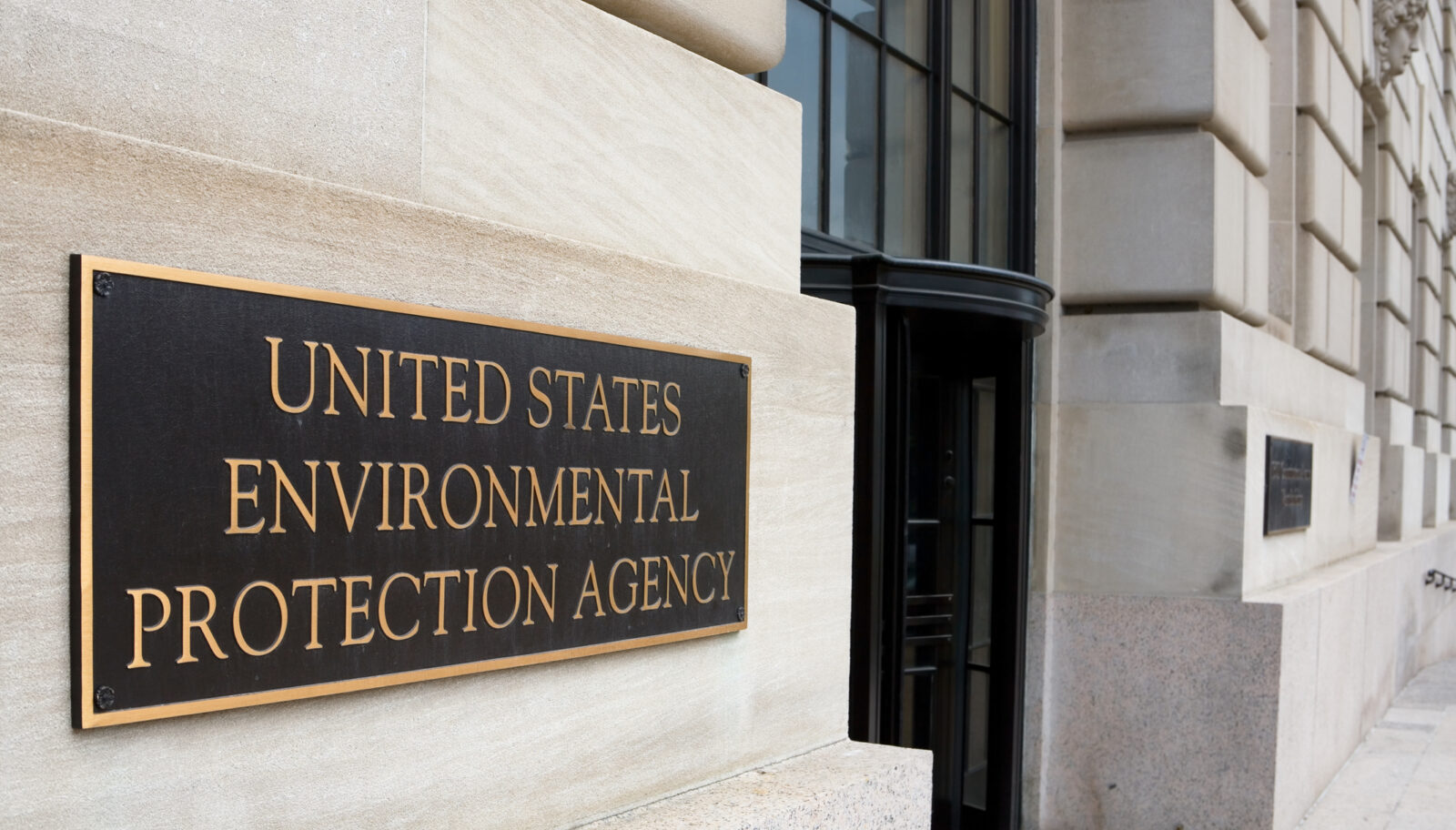
Manufacturers have long led the way in efforts to reduce air pollution and improve air quality. Yet, new proposed regulations from the federal government will work against these efforts instead of bolstering them, stymying critical progress and destabilizing economic growth at a time when both are more important than ever.
The challenge: The Environmental Protection Agency is considering a new rule that would impose stricter air standards on particulate matter known as PM2.5 (i.e., particles that measure two and a half micrometers or less in diameter). This rule would enact significant top-down restrictions, forcing manufacturers to change their operations abruptly and without any support.
The reality: For years, manufacturers across all sectors have been developing smart, innovative ways to use energy, water and other resources more sustainably—all while boosting economic growth and creating good jobs at the same time.
- Today, manufacturing in the U.S. is cleaner and greener than at any other time in history, largely due to a revolution in how manufacturers produce, use and recycle energy and resources.
- Across the board, levels of major pollutants have declined dramatically over the past few decades. Thanks to existing regulations and a culture of innovation, the U.S. is far outpacing global competitors in environmental stewardship.
By the numbers: According to the EPA, the U.S. reduced six common pollutants covered by National Ambient Air Quality Standards, including PM2.5, by 78% between 1970 and 2020. In fact, PM2.5 levels alone have dropped a full 44% since 2000.
The impact: These new regulations could be devastating for manufacturers and for the climate. Here are just a few of the negative repercussions:
- An additional regulatory burden on businesses will drain resources from innovative manufacturers, posing additional hurdles to the investment in research and development that fuels progress in energy efficiency and climate action.
- Making permitting harder could also jeopardize new clean energy projects that America needs to address climate change.
- The standards will hinder onshoring, resulting in continued manufacturing abroad—which is less clean than manufacturing in the U.S. The EPA’s proposal undercuts U.S. competitiveness and will not further the goal of global emissions reduction.
- New regulations could damage an already-slowing economy, increasing costs and constraining job growth at a time when Americans are grappling with record inflation.
Our view: Rather than imposing new and unnecessary obligations on manufacturers, the federal government should focus on enforcing the strong regulations that are already in place and give manufacturers the space to find better solutions.
- “The EPA’s announcement . . . [about reconsidering] the PM 2.5 standard will only further weaken an already slowing economy,” said NAM President and CEO Jay Timmons. “Let manufacturers do what they do best: innovate and deploy modern technologies to protect the environment, while creating jobs and strengthening the economy.”
NAM in action: The NAM is rallying manufacturers to speak out against the EPA’s proposal and calling on Congress to oppose these harmful regulations.
- Manufacturers can show their support by sending an email to decision makers in Washington, explaining the real impact of this damaging proposal and urging them to stand up against unnecessary regulations.
Join in: There is an EPA hearing to discuss the proposal on Feb. 21. To participate, be sure to sign up soon—the registration deadline is Feb. 16.
